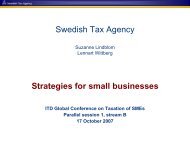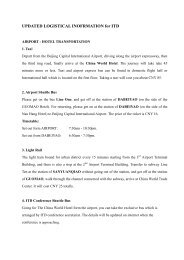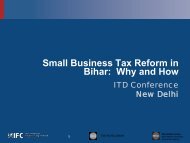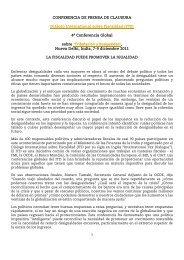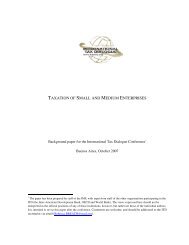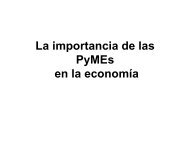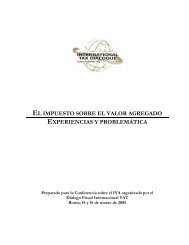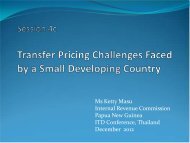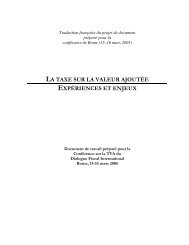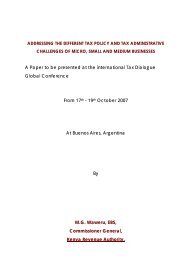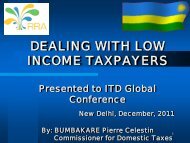Arcotia Hatsidimitris - International Tax Dialogue
Arcotia Hatsidimitris - International Tax Dialogue
Arcotia Hatsidimitris - International Tax Dialogue
Create successful ePaper yourself
Turn your PDF publications into a flip-book with our unique Google optimized e-Paper software.
2. SELECTING THE RIGHT CASES – 23<br />
Information sources – third parties<br />
In addition to the data provided initially by the business, tax administrations are increasingly<br />
using a range of other data and expertise, available both from other branches of government and<br />
externally, to refine their analysis and improve their assessment of transfer pricing risks.<br />
Databases: such as the Forecasting Analysis and Modelling Environment (FAME) take<br />
information from a variety of publicly available sources and provide a way of finding companies that<br />
are carrying out broadly similar activities to the company under review. If the financial results of the<br />
company under enquiry are completely outside the range of the apparent comparables, though the<br />
breadth of the range makes this unlikely, this may be an indication that the case is worth looking at in<br />
more detail. However, a thorough analysis is always necessary to fully understand differences between<br />
a business and potential comparables. Where results are inconclusive tax administrations will need to<br />
consider other factors.<br />
Customs data: It is possible to use data collected for the purposes of assessing customs duties to<br />
obtain details of cross border transactions, including those between connected parties particularly as<br />
Customs data tends to be collected and available in real time. However, the existence of a crossborder<br />
movement of goods is not always indicative of a transaction (as goods often move intra-group<br />
without change of ownership), and other transactions, such as royalty flows, do not show up in<br />
customs data. Moreover, without knowledge of the ownership of the intangible property rights<br />
associated with many goods it can be difficult to assess instances of under or overvaluation.<br />
Patent office: In Denmark the central transfer pricing team has tried to build a closer working<br />
relationship with the Patent and Trademarks Office, in order to help identify cases where cross border<br />
transfers of intellectual property have taken place and to obtain a better understanding of what<br />
intellectual property a business is developing. However, patents can be very difficult to understand.<br />
Moreover, many intra-group transfers of intellectual property take place by licence without any<br />
notification of transfer to official registries. In a similar way, transfer or registration of a patent can<br />
take place without change of beneficial ownership and in these circumstances there would be no<br />
implications for transfer pricing. The UK has recently acquired data from its Intellectual Property<br />
Office related to overseas transfers of patents, design rights and other intellectual property to further<br />
inform transfer pricing risk assessment. The data is currently being analysed by HMRC’s transfer<br />
pricing specialists.<br />
<strong>Tax</strong> treaty intelligence, including JITSIC 3 : Information received from other tax<br />
administrations, either spontaneously or as a result of a specific request, may assist in identifying<br />
transfer pricing risks. JITSIC members, for example, have found spontaneous exchanges very<br />
productive in identifying, and therefore tackling, transfer pricing risks. Spontaneous exchanges of<br />
information under double taxation agreements are encouraged so that information is exchanged at the<br />
earliest opportunity ensuring that the deadline for opening a transfer pricing audit or enquiry is not<br />
missed.<br />
Press reports, trade magazines and other information in the public domain: These sources<br />
can provide useful information on both particular companies and their trade sectors. Information on<br />
business sectors can help decide whether declining results for a company reflect a wider malaise for<br />
that particular business sector, or reveal that the sector was in fact rather buoyant during the period in<br />
question. Articles on business sectors may also indicate when a competitor has launched a rival<br />
product, which might explain a fall in sales for the company being reviewed.<br />
DEALING EFFECTIVELY WITH THE CHALLENGES OF TRANSFER PRICING © OECD 2012



